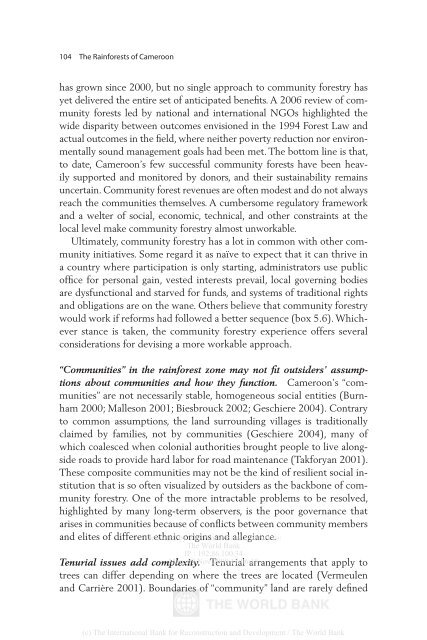The Rainforests of Cameroon - PROFOR
The Rainforests of Cameroon - PROFOR
The Rainforests of Cameroon - PROFOR
- No tags were found...
Create successful ePaper yourself
Turn your PDF publications into a flip-book with our unique Google optimized e-Paper software.
104 <strong>The</strong> <strong>Rainforests</strong> <strong>of</strong> <strong>Cameroon</strong>has grown since 2000, but no single approach to community forestry hasyet delivered the entire set <strong>of</strong> anticipated benefits. A 2006 review <strong>of</strong> communityforests led by national and international NGOs highlighted thewide disparity between outcomes envisioned in the 1994 Forest Law andactual outcomes in the field, where neither poverty reduction nor environmentallysound management goals had been met. <strong>The</strong> bottom line is that,to date, <strong>Cameroon</strong>’s few successful community forests have been heavilysupported and monitored by donors, and their sustainability remainsuncertain. Community forest revenues are <strong>of</strong>ten modest and do not alwaysreach the communities themselves. A cumbersome regulatory frameworkand a welter <strong>of</strong> social, economic, technical, and other constraints at thelocal level make community forestry almost unworkable.Ultimately, community forestry has a lot in common with other communityinitiatives. Some regard it as naïve to expect that it can thrive ina country where participation is only starting, administrators use public<strong>of</strong>fice for personal gain, vested interests prevail, local governing bodiesare dysfunctional and starved for funds, and systems <strong>of</strong> traditional rightsand obligations are on the wane. Others believe that community forestrywould work if reforms had followed a better sequence (box 5.6). Whicheverstance is taken, the community forestry experience <strong>of</strong>fers severalconsiderations for devising a more workable approach.“Communities” in the rainforest zone may not fit outsiders’ assumptionsabout communities and how they function. <strong>Cameroon</strong>’s “communities”are not necessarily stable, homogeneous social entities (Burnham2000; Malleson 2001; Biesbrouck 2002; Geschiere 2004). Contraryto common assumptions, the land surrounding villages is traditionallyclaimed by families, not by communities (Geschiere 2004), many <strong>of</strong>which coalesced when colonial authorities brought people to live alongsideroads to provide hard labor for road maintenance (Takforyan 2001).<strong>The</strong>se composite communities may not be the kind <strong>of</strong> resilient social institutionthat is so <strong>of</strong>ten visualized by outsiders as the backbone <strong>of</strong> communityforestry. One <strong>of</strong> the more intractable problems to be resolved,highlighted by many long-term observers, is the poor governance thatarises in communities because <strong>of</strong> conflicts between community membersand elites <strong>of</strong> different Delivered ethnic by origins <strong>The</strong> World and Bank allegiance. e-library to:<strong>The</strong> World BankIP : 192.86.100.34Tenurial issues add complexity. Mon, 09 Nov Tenurial 2009 17:06:18 arrangements that apply totrees can differ depending on where the trees are located (Vermeulenand Carrière 2001). Boundaries <strong>of</strong> “community” land are rarely defined(c) <strong>The</strong> International Bank for Reconstruction and Development / <strong>The</strong> World Bank
















